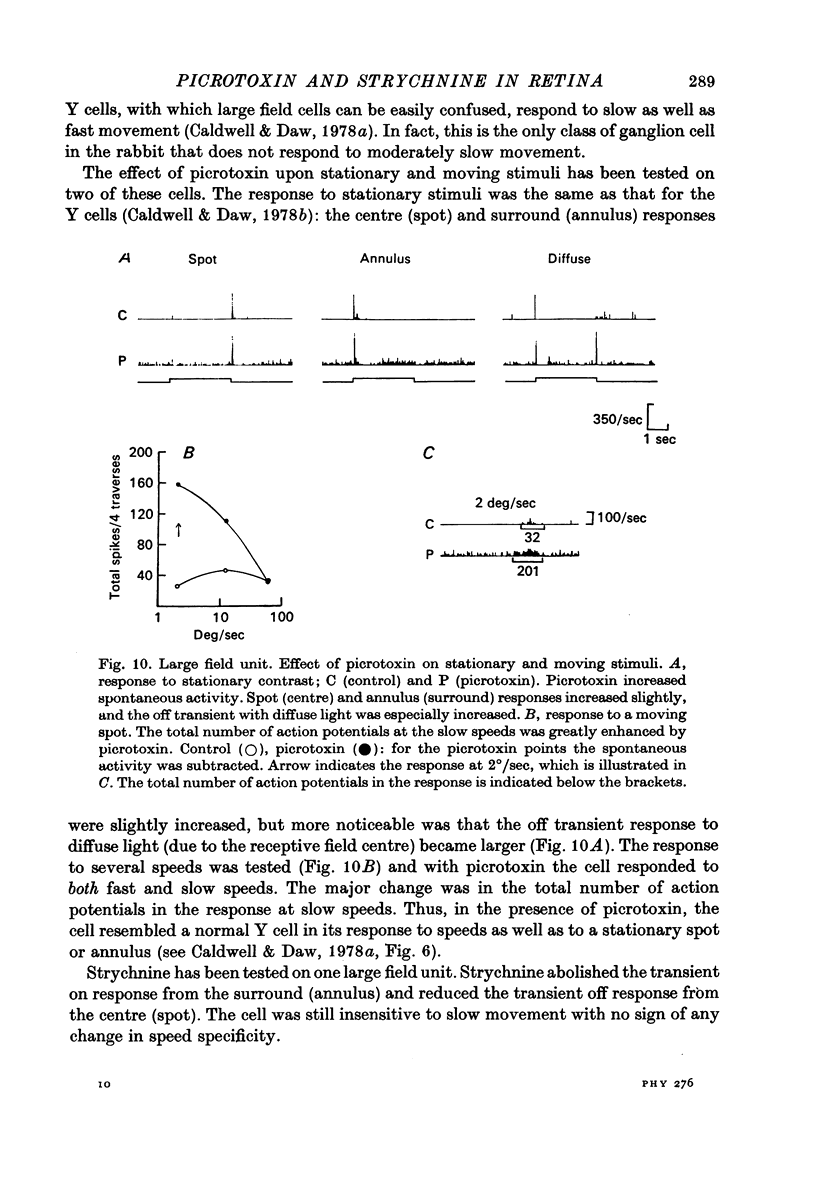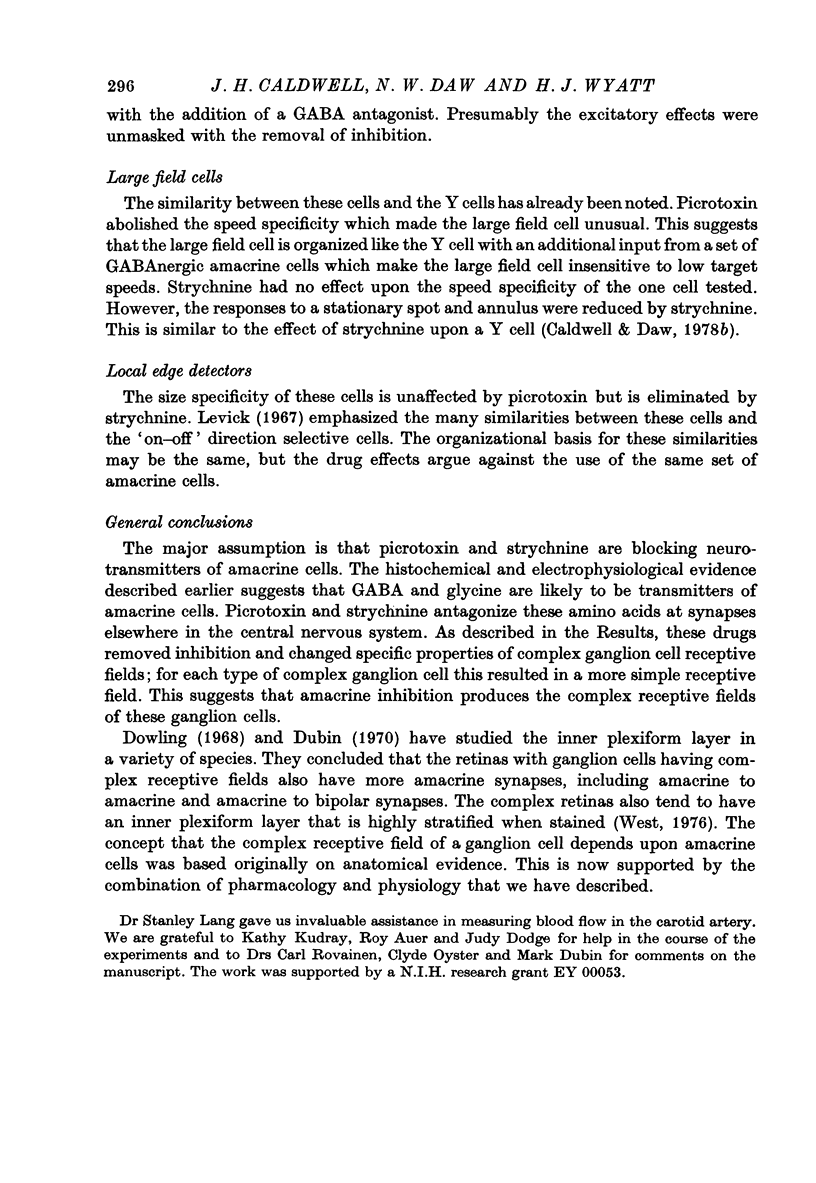Abstract
1. The effects of picrotoxin and strychnine were tested on the receptive fields of direction sensitive cells, orientation sensitive cells, local edge detectors, uniformity detectors and large field units in the rabbit retina. 2. Picrotoxin eliminated the direction specificity and size specificity of 'on-off' and 'on' directionally sensitive cells for both black and white objects. Picrotoxin also made 'on' directionally sensitive cells responsive to faster velocities. 3. Picrotoxin eliminated the orientation specificity of orientation sensitive cells, and changed the bar-flank arrangement of the receptive field into a centre surround arrangement. Thus, the orientation specificity is due to inhibitory rather than excitatory mechanisms. 4. Picrotoxin altered the speed sensitivity of large field units so that they responded to slow speeds as well as fast ones, like centre surround Y cells. 5. Strychnine abolished the size specificity of local edge detectors and changed their speed specificity so that they responded to faster speeds. 6. Picrotoxin changed a uniformity detector into a sustained on centre cell. 7. Strychnine did not effect the direction specificity of directionally sensitive cells, the orientation specificity of orientation sensitive cells, or the speed specificity of large field units. Picrotoxin did not affect the size specificity of local edge detectors. 8. Picrotoxin and strychnine usually had opposing effects on the transient responses of these units to spots and annuli. In general picrotoxin prolonged and enhanced these responses at both on and off, and strychnine shortened them. 9. The effect of these drugs for every type of ganglion cell with complex receptive field properties was to make the receptive field more simple. The orientation selective cells, large field cells, 'on' direction selective cells and uniformity detectors seem to be centre surround cells with special properties that are abolished by these drugs. The 'on-off' direction selective cells and local edge detectors still on-off receptive fields, but in each case one of the drugs abolished the feature that was the basis for the cell's name.
Full text
PDF





















Selected References
These references are in PubMed. This may not be the complete list of references from this article.
- Adrian E. D., Matthews R. The action of light on the eye: Part III. The interaction of retinal neurones. J Physiol. 1928 Jun 24;65(3):273–298. doi: 10.1113/jphysiol.1928.sp002475. [DOI] [PMC free article] [PubMed] [Google Scholar]
- Ames A., 3rd, Pollen D. A. Neurotransmission in central nervous tissue: a study of isolated rabbit retina. J Neurophysiol. 1969 May;32(3):424–442. doi: 10.1152/jn.1969.32.3.424. [DOI] [PubMed] [Google Scholar]
- BARLOW H. B., HILL R. M., LEVICK W. R. RETINAL GANGLION CELLS RESPONDING SELECTIVELY TO DIRECTION AND SPEED OF IMAGE MOTION IN THE RABBIT. J Physiol. 1964 Oct;173:377–407. doi: 10.1113/jphysiol.1964.sp007463. [DOI] [PMC free article] [PubMed] [Google Scholar]
- BARLOW H. B., HILL R. M. Selective sensitivity to direction of movement in ganglion cells of the rabbit retina. Science. 1963 Feb 1;139(3553):412–414. doi: 10.1126/science.139.3553.412. [DOI] [PubMed] [Google Scholar]
- Barlow H. B., Levick W. R. The mechanism of directionally selective units in rabbit's retina. J Physiol. 1965 Jun;178(3):477–504. doi: 10.1113/jphysiol.1965.sp007638. [DOI] [PMC free article] [PubMed] [Google Scholar]
- Bishop P. O., Coombs J. S., Henry G. H. Receptive fields of simple cells in the cat striate cortex. J Physiol. 1973 May;231(1):31–60. doi: 10.1113/jphysiol.1973.sp010218. [DOI] [PMC free article] [PubMed] [Google Scholar]
- Bruun A., Ehinger B. Uptake of certain possible neurotransmitters into retinal neurons of some mammals. Exp Eye Res. 1974 Nov;19(5):435–447. doi: 10.1016/0014-4835(74)90052-9. [DOI] [PubMed] [Google Scholar]
- Bruun A., Ehinger B. Uptake of the putative neurotransmitter, glycine, into the rabbit retina. Invest Ophthalmol. 1972 Apr;11(4):191–198. [PubMed] [Google Scholar]
- Burkhardt D. A. Effects of picrotoxin and strychnine upon electrical activity of the proximal retina. Brain Res. 1972 Aug 11;43(1):246–249. doi: 10.1016/0006-8993(72)90289-2. [DOI] [PubMed] [Google Scholar]
- Burkhardt D. A. Proximal negative response of frog retina. J Neurophysiol. 1970 May;33(3):405–420. doi: 10.1152/jn.1970.33.3.405. [DOI] [PubMed] [Google Scholar]
- Caldwell J. H., Daw N. W. Effects of picrotoxin and strychnine on rabbit retinal ganglion cells: changes in centre surround receptive fields. J Physiol. 1978 Mar;276:299–310. doi: 10.1113/jphysiol.1978.sp012234. [DOI] [PMC free article] [PubMed] [Google Scholar]
- Caldwell J. H., Daw N. W. New properties of rabbit retinal ganglion cells. J Physiol. 1978 Mar;276:257–276. doi: 10.1113/jphysiol.1978.sp012232. [DOI] [PMC free article] [PubMed] [Google Scholar]
- Creutzfeldt O. D., Kuhnt U., Benevento L. A. An intracellular analysis of visual cortical neurones to moving stimuli: response in a co-operative neuronal network. Exp Brain Res. 1974;21(3):251–274. doi: 10.1007/BF00235746. [DOI] [PubMed] [Google Scholar]
- Creutzfeldt O., Ito M. Functional synaptic organization of primary visual cortex neurones in the cat. Exp Brain Res. 1968;6(4):324–352. doi: 10.1007/BF00233183. [DOI] [PubMed] [Google Scholar]
- Curtis D. R., Duggan A. W., Johnston G. A. The specificity of strychnine as a glycine antagonist in the mammalian spinal cord. Exp Brain Res. 1971 Jun 29;12(5):547–565. doi: 10.1007/BF00234248. [DOI] [PubMed] [Google Scholar]
- Curtis D. R., Hösli L., Johnston G. A. A pharmacological study of the depression of spinal neurones by glycine and related amino acids. Exp Brain Res. 1968;6(1):1–18. doi: 10.1007/BF00235443. [DOI] [PubMed] [Google Scholar]
- Curtis D. R., Johnston G. A. Amino acid transmitters in the mammalian central nervous system. Ergeb Physiol. 1974;69(0):97–188. doi: 10.1007/3-540-06498-2_3. [DOI] [PubMed] [Google Scholar]
- Daniels J. D., Pettigrew J. D. A study of inhibitory antagonism in cat visual cortex. Brain Res. 1975 Jul 25;93(1):41–62. doi: 10.1016/0006-8993(75)90285-1. [DOI] [PubMed] [Google Scholar]
- Diamond J., Roper S., Yasargil G. M. The membrane effects, and sensitivity to strychnine, of neural inhibition of the Mauthner cell, and its inhibition by glycine and GABA. J Physiol. 1973 Jul;232(1):87–111. doi: 10.1113/jphysiol.1973.sp010258. [DOI] [PMC free article] [PubMed] [Google Scholar]
- Dowling J. E. Synaptic organization of the frog retina: an electron microscopic analysis comparing the retinas of frogs and primates. Proc R Soc Lond B Biol Sci. 1968 Jun 11;170(1019):205–228. doi: 10.1098/rspb.1968.0034. [DOI] [PubMed] [Google Scholar]
- Dubin M. W. The inner plexiform layer of the vertebrate retina: a quantitative and comparative electron microscopic analysis. J Comp Neurol. 1970 Dec;140(4):479–505. doi: 10.1002/cne.901400406. [DOI] [PubMed] [Google Scholar]
- Ehinger B. Autoradiographic identification of rabbit retinal neurons that take up GABA. Experientia. 1970 Oct 15;26(10):1063–1064. doi: 10.1007/BF02112673. [DOI] [PubMed] [Google Scholar]
- Ehinger B. Cellular location of the uptake of some amino acids into the rabbit retina. Brain Res. 1972 Nov 13;46:297–311. doi: 10.1016/0006-8993(72)90021-2. [DOI] [PubMed] [Google Scholar]
- Ehinger B., Falck B. Autoradiography of some suspected neurotransmitter substances: GABA glycine, glutamic acid, histamine, dopamine, and L-dopa. Brain Res. 1971 Oct 8;33(1):157–172. doi: 10.1016/0006-8993(71)90314-3. [DOI] [PubMed] [Google Scholar]
- Ehinger B. Selective neuronal accumulation of omega-amino acids in the rabbit retina. Brain Res. 1976 May 14;107(3):541–554. doi: 10.1016/0006-8993(76)90143-8. [DOI] [PubMed] [Google Scholar]
- Emerson R. C., Gerstein G. L. Simple striate neurons in the cat. II. Mechanisms underlying directional asymmetry and directional selectivity. J Neurophysiol. 1977 Jan;40(1):136–155. doi: 10.1152/jn.1977.40.1.136. [DOI] [PubMed] [Google Scholar]
- Gallego A. Horizontal and amacrine cells in the mammal's retina. Vision Res. 1971;Suppl 3:33–50. doi: 10.1016/0042-6989(71)90029-0. [DOI] [PubMed] [Google Scholar]
- HUBEL D. H., WIESEL T. N. Receptive fields, binocular interaction and functional architecture in the cat's visual cortex. J Physiol. 1962 Jan;160:106–154. doi: 10.1113/jphysiol.1962.sp006837. [DOI] [PMC free article] [PubMed] [Google Scholar]
- Henry G. H., Bishop P. O. Striate neurons: receptive field organization. Invest Ophthalmol. 1972 May;11(5):357–368. [PubMed] [Google Scholar]
- Henry G. H., Dreher B., Bishop P. O. Orientation specificity of cells in cat striate cortex. J Neurophysiol. 1974 Nov;37(6):1394–1409. doi: 10.1152/jn.1974.37.6.1394. [DOI] [PubMed] [Google Scholar]
- Kirby A. W., Enroth-Cugell C. The involvement of gamma-aminobutyric acid in the organization of cat retinal ganglion cell receptive fields. A study with picrotoxin and bicuculline. J Gen Physiol. 1976 Oct;68(4):465–484. doi: 10.1085/jgp.68.4.465. [DOI] [PMC free article] [PubMed] [Google Scholar]
- Kuriyama K., Sisken B., Haber B., Roberts E. The gamma-aminobutyric acid system in rabbit retina. Brain Res. 1968 Jun;9(1):165–168. doi: 10.1016/0006-8993(68)90269-2. [DOI] [PubMed] [Google Scholar]
- Landau E. M. The effect of strychnine on the neuro-muscular junction of the rat. Life Sci. 1967 Dec 1;6(23):2515–2517. doi: 10.1016/0024-3205(67)90315-3. [DOI] [PubMed] [Google Scholar]
- Levick W. R. Receptive fields and trigger features of ganglion cells in the visual streak of the rabbits retina. J Physiol. 1967 Feb;188(3):285–307. doi: 10.1113/jphysiol.1967.sp008140. [DOI] [PMC free article] [PubMed] [Google Scholar]
- Marshall J., Voaden M. Autoradiographic identification of the cells accumulating 3H gamma-aminobutyric acid in mammalian retinae: a species comparison. Vision Res. 1975 Mar;15(3):459–461. doi: 10.1016/0042-6989(75)90102-9. [DOI] [PubMed] [Google Scholar]
- Miller R. F., Dacheux R. F., Frumkes T. E. Amacrine cells in Necturus retina: evidence for independent gamma-aminobutyric acid- and glycine-releasing neurons. Science. 1977 Nov 18;198(4318):748–750. doi: 10.1126/science.910159. [DOI] [PubMed] [Google Scholar]
- Obata K., Takeda K., Shinozaki H. Further study on pharmacological properties of the cerebellar-induced inhibition of deiters neurones. Exp Brain Res. 1970 Nov 26;11(4):327–342. doi: 10.1007/BF00237907. [DOI] [PubMed] [Google Scholar]
- Oyster C. W. The analysis of image motion by the rabbit retina. J Physiol. 1968 Dec;199(3):613–635. doi: 10.1113/jphysiol.1968.sp008671. [DOI] [PMC free article] [PubMed] [Google Scholar]
- Rose D., Blakemore C. Effects of bicuculline on functions of inhibition in visual cortex. Nature. 1974 May 24;249(455):375–377. doi: 10.1038/249375a0. [DOI] [PubMed] [Google Scholar]
- Sillito A. M. The contribution of inhibitory mechanisms to the receptive field properties of neurones in the striate cortex of the cat. J Physiol. 1975 Sep;250(2):305–329. doi: 10.1113/jphysiol.1975.sp011056. [DOI] [PMC free article] [PubMed] [Google Scholar]
- Sillito A. M., Versiani V. Synaptic mechanisms contributing to the lenght preference of hypercomplex cells [proceedings]. J Physiol. 1976 Dec;263(1):171P–172P. [PubMed] [Google Scholar]
- Werblin F. S. Lateral interactions at inner plexiform layer of vertebrate retina: antagonistic responses to change. Science. 1972 Mar 3;175(4025):1008–1010. doi: 10.1126/science.175.4025.1008. [DOI] [PubMed] [Google Scholar]
- Werblin F. S. Response of retinal cells to moving spots: intracellular recording in Necturus maculosus. J Neurophysiol. 1970 May;33(3):342–350. doi: 10.1152/jn.1970.33.3.342. [DOI] [PubMed] [Google Scholar]
- Werman R., Davidoff R. A., Aprison M. H. Inhibitory of glycine on spinal neurons in the cat. J Neurophysiol. 1968 Jan;31(1):81–95. doi: 10.1152/jn.1968.31.1.81. [DOI] [PubMed] [Google Scholar]
- West R. W. Light and electron microscopy of the ground squirrel retina: functional considerations. J Comp Neurol. 1976 Aug 1;168(3):355–377. doi: 10.1002/cne.901680304. [DOI] [PubMed] [Google Scholar]
- Wyatt H. J., Daw N. W. Directionally sensitive ganglion cells in the rabbit retina: specificity for stimulus direction, size, and speed. J Neurophysiol. 1975 May;38(3):613–626. doi: 10.1152/jn.1975.38.3.613. [DOI] [PubMed] [Google Scholar]
- Wyatt H. J., Day N. W. Specific effects of neurotransmitter antagonists on ganglion cells in rabbit retina. Science. 1976 Jan 16;191(4223):204–205. doi: 10.1126/science.1857. [DOI] [PubMed] [Google Scholar]


